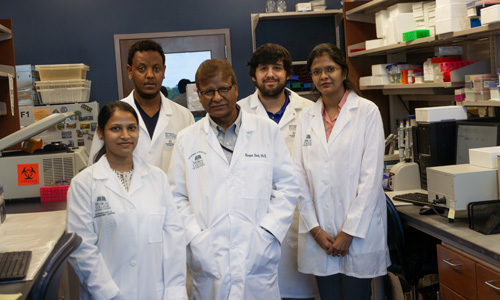About BioModME | Capabilities | Unique Functionality | Get BioModME | Resources | Acknowledgments
Developed in the Computational Systems Biology Laboratory in the Marquette University and Medical College of Wisconsin Joint Department of Biomedical Engineering by BME graduate student Justin Womack and in collaboration with the Terhune laboratory, the BioModME is a standalone R/Shiny-based web application package that provides investigators with an intuitive, comprehensive graphical user interface to build, solve, visualize, and analyze computational models for complex biological systems.
About BioModME
Biological systems and the associated regulating mechanisms and disease processes are intrinsically complex, often encompassing a vast number of interacting and redundant components that have become increasingly difficult, if not impossible, to assess experimentally. In addition, many of these components are unintuitive in nature, requiring alternative approaches to determine the underlying functions of the associated network. Computational modeling, the process of simulating complex systems in silico, has emerged as a powerful tool for generating testable hypotheses of the system by predicting different possible responses of the system to perturbations. BioModME is an R-based web application built using the Shiny framework for expedient biological system modeling and simulations. It provides the users with an all-encompassing and code-free computational model building tool to define reaction networks, develop and simulate computational models, and analyze the behavior of complex biological systems.
What Can you do with BioModME?
Define Reaction Networks
The BioModME provides modules that aid investigators in systematic production of unique reaction network models for complex biological systems in the graphical user interface without the need for knowledge of a computer-programming language. BioModME then converts reaction networks into appropriate mathematical equations, allowing non-expert users, including bench biologists and clinicians, to avoid all tedious mathematical derivations of the equations.
Develop and Simulate Computational Models
BioModME provides a model-building suite that allows the user to create dynamic biological system models from reaction networks using various chemical and physical laws, including the law of mass balance, the law of mass action, and Michaelis-Menten kinetics for enzyme-catalyzed reactions. BioModME has in-built efficient numerical algorithms for solving differential and algebraic equations and performing optimization for model parameter estimation from experimental data.
Analyze the Behavior of Biological Systems
R visualization packages are used to present the simulation results in meaningful ways in the graphical user interface with options to export the model information, plots, results, and underlying codes to other platforms. BioModME also provides interactive data tables for organizing and editing model information such as parameter values and performing and visualizing simulation results with altered parameter values.
Learn More About BioModME's Unique Functionality
Important features of the application package include multi-compartmental system modeling, custom reaction rate laws and equations, unit conversion, model parameter estimation utilizing experimental data, and SBML exports and imports of models. The users can also export the models to MATLAB, R, and Python languages. Equations can be exported to LaTex and MathML formats. The application package also includes an online model development platform, multi-modality visualization tool, and efficient numerical solvers for differential-algebraic equations and optimization.
Get BioModME
BioModME is free to use and easily accessed through the links below.
Access BioModME online through CTSI
Download the BioModME Application source code
Resources
BioModME Documentation & Tutorials
Acknowledgments
This work was supported in part by the National Institutes of Health, as well as the Marquette University and Medical College of Wisconsin Joint Department of Biomedical Engineering. Special thanks are extended to Brad Taylor, George Kowalski and Kent Brodie of the Clinical and Translational Science Institute of Southeast Wisconsin for their technical support, as well as the Dash Lab members at the Medical College of Wisconsin for their suggestions and initial testing of this project.


